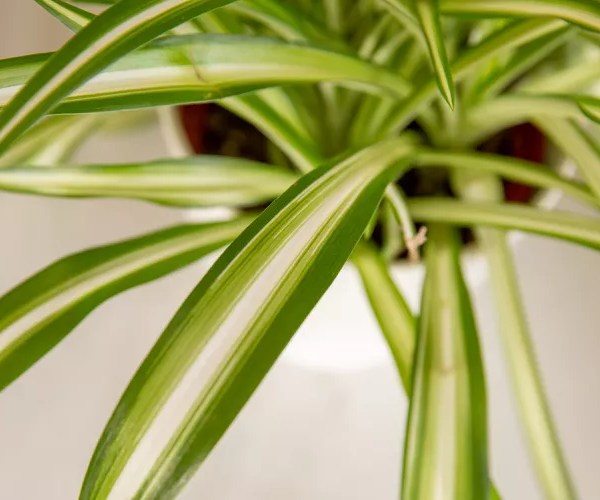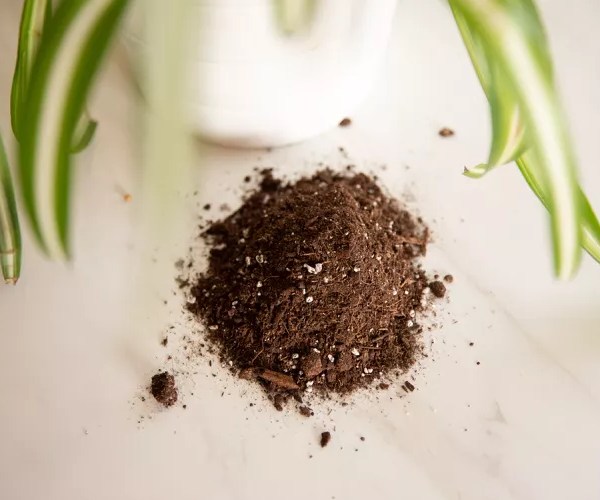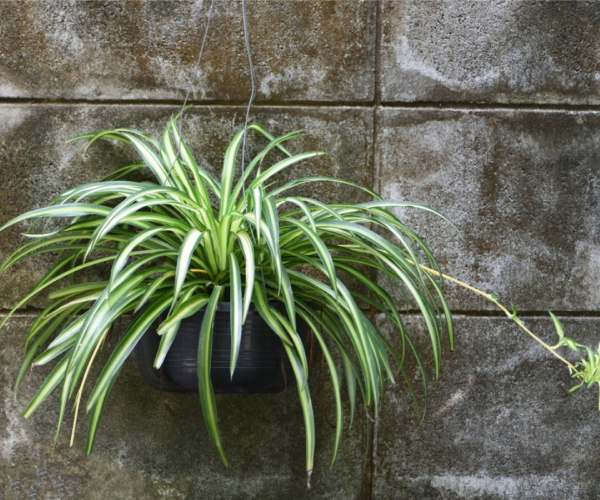Spider plants (Chlorophytum comosum) are among the most well-known houseplants to grow. These plants with creepy-crawly names are fast-growing and can easily be planted at any time of the year as long as it is not frosty. These plants grow rosettes of slim, gently arching leaves that can stretch from 12 to 18 inches long. Its leaves can be green or striped green and white. Mature plants have long, slender stems that can bear tiny, star-shaped flowers. Once fertilized, the flowers will form a small fruit, and once the flower falls off, small plantlets form in their spot, which at last grow their own roots that you can snip off to create new potted plants.
Plant Attributes
- Common Names: Spider plants, spider ivy, ribbon plant
- Botanical Name: Chlorophytum comosum
- Family: Asparagaceae
- Plant Type: Herbaceous, perennial
- Mature Size: 1–2 ft. tall and wide
- Sun Exposure: Partial, shade
- Soil Type: Loamy, well-drained
- Bloom Time: Flowers regularly
- Bloom pH: Neutral
- Flower Color: White
- Hardiness Zone: 9–11 (USDA)
- Native Area: Central and Southern Africa
Spider Plant Care
Here are the main care requirements for growing spider plants:
- Plant in moist, loamy soil with good drainage.
- Prefers to grow in light shade.
- Does well in containers
- Water and fertilize regularly throughout the growing season (spring to fall).
- Thrives in warm and humid conditions.
Light
If grown outdoors, spider plants prefer growing in light shade. They are good at tolerating heavy shade, but their growth won’t be massive. Exposure to direct sunlight can scorch the leaves. Indoors, a bright window or patio door that gets indirect sun is the best spot.

Soil
Spider plants can grow in a variety of soil types. However, they prefer loamy soil with proper drainage. They prefer a fairly neutral soil pH but can also tolerate a slightly acidic alkaline soil.
Water
These plants prefer moist soil but hate soggy soil, Overwatering can cause the plant’s roots to rot and kill the plant eventually. Since these plants are sensitive to fluoride and chlorine in water, overwatering can cause the leaf tips to be brown. If possible use rain water or distilled water for potted plants. Inconsistent watering won’t harm the plants much since their fleshy tubers retain moisture well.
Temperature and Humidity
Spider plants love warm and humid conditions. They don’t prefer it when the temperature goes below 50 degrees Fahrenheit. This means you should protect them from drafts and air-conditioning vents when growing indoors. Regular misting of the plants can also help in maintaining enough humidity.
Fertilizer
These plants enjoy some amount of feeding almost once a month during the active growing seasons of spring and summer. While too little fertilizer will result in weak growth of the plant, too much can cause the leaf tips to turn brown. You can use an all-purpose granular or water-soluble fertilizer during the growing season, following label instructions. Depending on your plant’s growth, you can adjust the amount if necessary.

Types of Spider Plants
There are many varieties of spider plants, including:
- Chlorophytum comosum ‘Variegatum‘: This variety has leaf margins of cream or white with a dark green stripe down the middle. Its long stems are green.
- Chlorophytum comosum ‘Vittatum‘: This plant’s leaves have a center white stripe surrounded by medium green margins. Its long stems are white.
- Chlorophytum comosum ‘Bonnie‘: This variety is more compact than the main species plant and has loosely curled leaves with green margins and a cream center stripe. It produces yellow flowers.
Pruning
If you notice any dead or browning leaves, remove them ASAP. If your plant is getting too leggy or sparse, remove the plantlet shoots to redirect energy to the main plant.
Also, Read Top 10 Poisonous Plants to Keep Out of Your Garden for Dog’s Safety
Propagating Spider Plants
Spider plants are very easy to propagate and are great growers so you will want to gift one to your friend. Even if you’re a beginner, you can do it.
- Once the small plantlets on a spider plant’s stem develop roots that are at least an inch or two long, it’s time to propagate. Using sharp pruners, carefully cut the plantlets off the stem, keeping the roots intact.
- Plant them in a well-draining clay or plastic container filled with the potting medium. Keep the soil moist (but not soggy) until they become established.
- For plantlets without developed roots, take a pot filled with potting soil near the parent plant. Place the plantlet on top of the soil in the new pot, and keep the soil moist. Within a few weeks, you will see roots develop. Snip the plantlet from the parent plant, and continue growing in the new pot.
- Also, mature plants can be dug up and divided. Pull apart the root ball into sections, keeping as many roots intact as possible. After that, replant the sections.
How to Grow Spider Plants from Seed
Growing spider plants from seed is not that common since propagating them by planting the offsets or dividing the roots is easier. However, if you still want to give this seeding method a go, here you are:
- It is essential to cross-pollinate the spider plants to produce fertile seeds. You can do that by using a small artist’s brush or cotton swab to brush across the individual blooms once they appear. Brush all the flowers to make sure that the pollens have transmitted to the blossoms.
- Once the flowers fade, you will see small green pods in their spot. You have to pluck the dried pods from the parent plants and collect their inside seeds.
- Finally, plant the seeds about 1/2 inch deep in a small pot filled with potting mix, and keep the mix warm and moist until the seeds sprout. Since fertility may depend, you need to plant a lot of seeds to make sure you succeed.
Potting and Repotting Spider Plant
Normally we grow spider plants in containers as hanging plants because of the cascading nature of their foliage and their long stems that have plantlets. In warmer climates, these plants do well in outdoor planters and as edging or ground cover plants.
If you’re planning to plant them in containers, make sure the pot isn’t 1/3 larger than the root ball. Also, know that the containers have proper drainage holes and use a loose potting mix. These plants will normally need repotting every couple of years. You will know it is time to repot them when you see roots coming out of the drainage holes and up above the soil line.

Spring is considered the best time to repot. Remove the plant from its old pot gently and keep it at the same depth in a slightly bigger pot. Then, add fresh potting mix.
Overwintering
Prevent fertilizing in the winter as spidies will go naturally semi-dormant. Watering and misting these plants regularly is necessary. They will need to be kept moist even during winter.
Common Pests & Plant Diseases
Normally spider plants are healthy plants but they are susceptible to some pests like aphids, whiteflies, and spider mites. If you see depreciated foliage, it is a sign of an infestation. A natural and effective way of controlling these infestations is to rinse the plants with water. You can also use an insecticide such as neem oil if the danger is serious.
Common Problems With Spider Plant
Spider plants rarely face serious problems and even if occurred, they can easily be solved.
Plant Is Too Sparse
Cutting off some of the baby plantlets can help as they help the plant redirect its energy in producing more shoots. Another way can be repotting and dividing a plant that has become overly root-bound. If the plant suddenly struggles after months of being active and healthy, it means it requires more room for its roots.
Leaf Burn
Like many other houseplants, spider plants are sensitive to the chemicals or salts that are found in treated tap water. It can cause the leaf tips to brown. If you see these signs in your plant, then use rainwater or untreated bottled water.
Leaf browning can also happen if a spider plant gets too much direct sunlight. Also, know that these plants love indirect light or shady conditions.
Browning Leaves
There are many reasons why spider plant’s leaves are getting brown. Too much fertilizer and lots of fluoride and chlorine in water can cause discoloration. Overwatering spider plants can lead to root rot, which causes browning leaves, as well. Moreover, the leaf tips can brown if the humidity is too low.
FAQs
Q: What is the best place to put a spider plant?
A: Spider plant can make an outdoor garden plant in warm climates (zones 9 to 11), and it is sometimes planted as an outdoor annual in colder climates. When used outdoors, it is normally planted as a garden bed edging plant or in window boxes or raised beds.
Q: Does spider plants clean the indoor air?
A: Yes, spider plants have been known to remove indoor pollutants such as formaldehyde from the air. It would take a very large indoor garden to fully purify the air in an entire house (by some estimates, as many as 700 plants would be needed) but a home with many houseplants will be a somewhat healthier one. And the effect of four or five spider plants in a small office will be noticeable.
Q: How long does a spider plant live?
A: Perennial plants with a good track record as houseplants generally earn that reputation because they are long-lived, and spider plant is no exception. Spider plants that are well cared for and regularly repotted and divided are often handed off from generation to generation.
